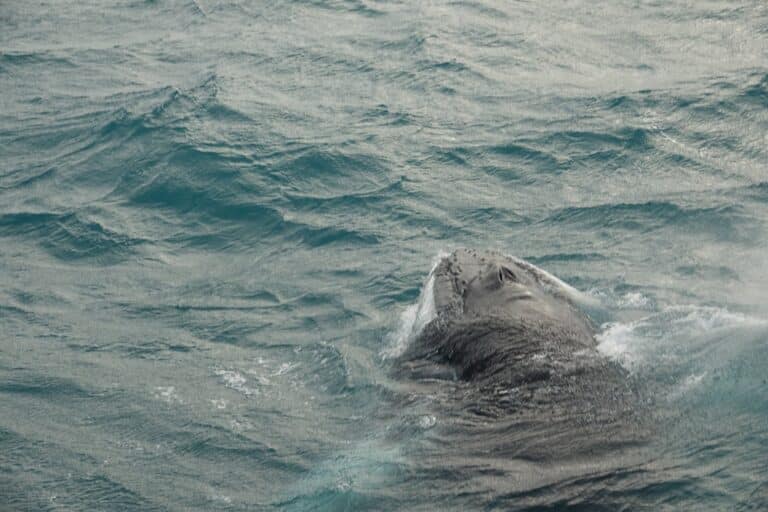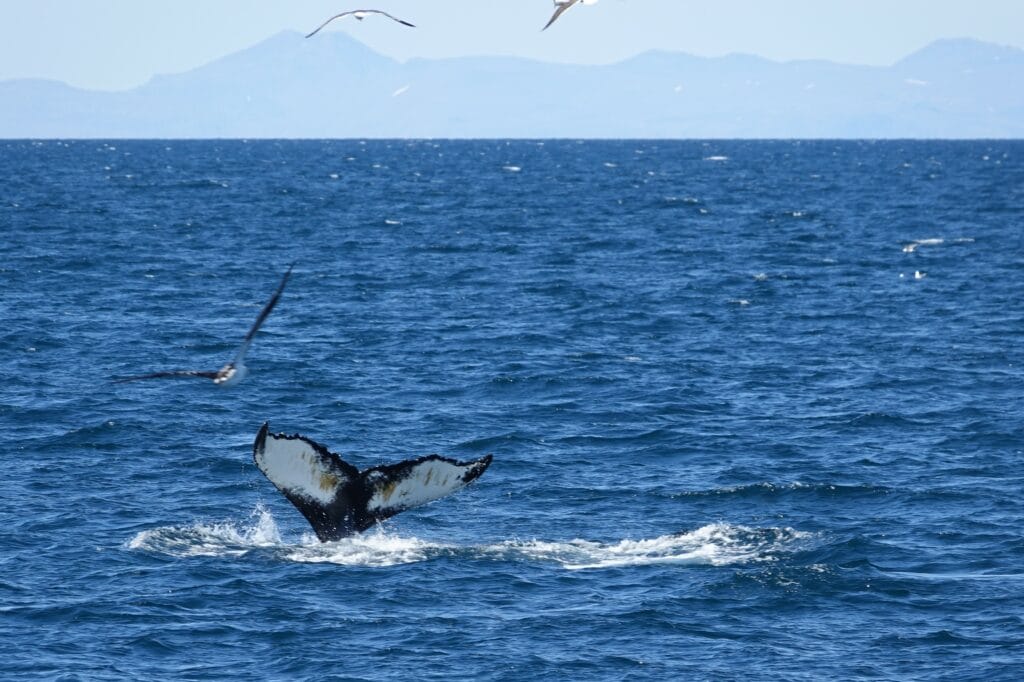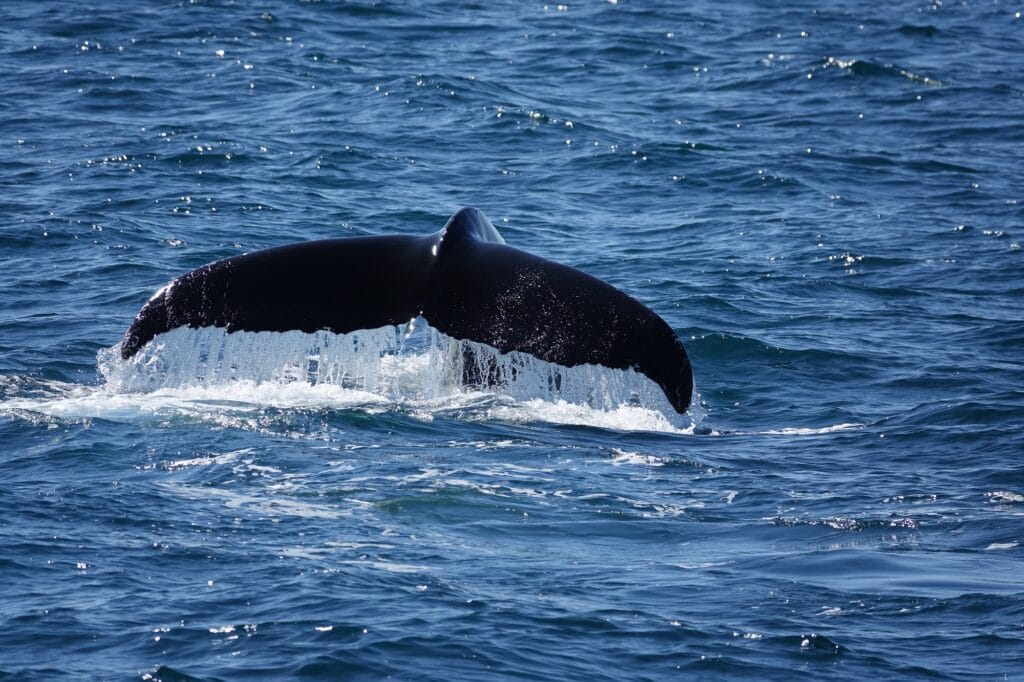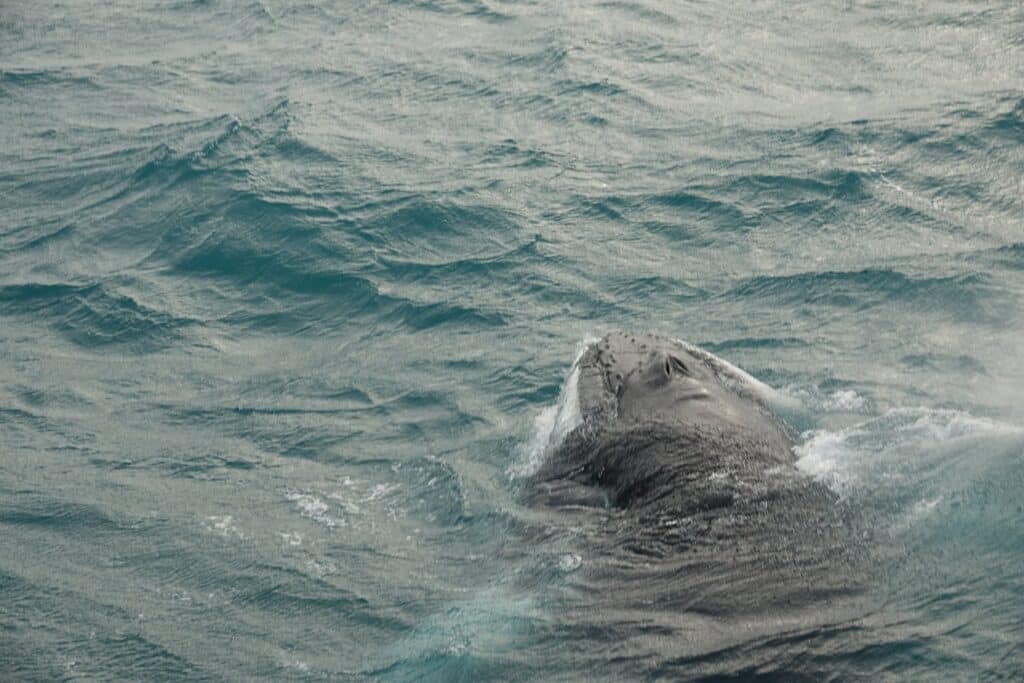Whale watching in front of an erupting volcano! #1 trip of the year so far.

We found humpback whales in front of the live volcano, as well as minkes, dolphins, and adorable puffins. The first arctic terns of the season were spotted too! Summer really is here. May 2021.
Written by Head Guide – Lucky Byfleet
It was a beautiful day here in Reykjavik, as sunny as it possibly can be and the small amount of wind didn’t disturb the seas. They were flat enough to see the footprints of the whales as they swam around us – something that is not always possible. Perfect weather to go whale watching on Amelia Rose, our superyacht. The visibility was incredible and we could see all the way to Snæfellsnes – the peninsular to the north of Reykjavik with a glacier on top of a dormant volcano…the live volcano is to the south. All in all the possible best conditions to go and find whales in the bay.
Setting out from the old harbour we made our way into Faxafloi, between the islands that were teeming with birdlife. The water was full of seaweed and other pieces of flotsam which indicates the ocean was pushing everything in towards the land – so the nutrients would also be being pushed in towards the shore. The fish follow the nutrients, and the cetaceans follow the fish. Things were looking good! The whole time we had a stunning backdrop of snow-covered mountains, and birds wheeling and darting around us. We continued further out with high expectations.
When we look for cetaceans we lookout for several things, firstly we look for birds, either in quantity or actively diving for fish, which we had already seen as soon as we left the harbour. Next, we look for dorsal fins. Whales, dolphins and porpoises have them, and very rarely, we find basking sharks in our waters, which we adore. It’s very rare to find them this far north and a real honour to see them, and it only happens in the warmest of months.
The third big indicator of how to spot a cetacean is a blow as they breathe out. As whales are mammals they breath air and are warm-blooded. So their breath makes a cloud of steam, much like ours does on a cold day, except theirs is wetter. Fish don’t make blows!

For more information on how we search for whales and dolphins, and learn how to be a pro-cetacean spotter yourself have a look at our guide here.
Once out past the marker buoy of the inner harbour we saw a lot of birds diving over a small feeding ground in line with the mouth of Hvalfjordur. Whalefjord. A promising name! We headed towards it, all eyes focused underneath them, however, there was nothing there but fish and the birds soon dispersed. At least it was a great example for our customers of the kind of bird behaviour we are on the lookout for, so they are trained up to help us spot whales for the rest of the trip.
Further out we found a small pod of curious white-beaked dolphins who came and investigated the ship. They were large, probably a group of males. Male dolphins are known to break off from their main pod to go hunting together for short periods of time, and their friendships can last for a lifetime – which can be up to half a century in the wild! Much much longer than dolphins live in captivity.
When the dolphins moved on we went out to a large feeding ground we know to be extremely rich in fish, and a prime place to spot whales. There were birds in every direction so we simply sat and waited. Just as we had explained to our customers that these were the type of birds we normally see around minke whales, one appeared out of nowhere only 20metres off the starboard side of the yacht! It breathed a couple of times before arching its sleek back and diving right under the boat. We didn’t see it again but saw a different minke with a chunkier dorsal fin way out towards the mountain called Esja.
As we started on our way towards the second whale we saw a huge blow right in front of the active volcano! Then a tail came up – unmistakably a humpback! We changed direction and headed down towards it. It was a long way off and had just dived, so there was a fair chance of us losing it, but this was the first humpback of the year! It was worth the risk. However, on our way to it we found another humpback, one with a distinct dorsal fin – shaped like a bottle top. We know this humpback well and have seen it many times over the years. Seeing it again after the winter was such a treat!
It wasn’t fussed by our presence, and the humpback swam around feeding, popping up for a minute to breath and then diving back down for another 10 minutes. It remaining relaxed and continuing to feed is extremely important to us, the welfare of our ocean mammals has to be our top priority and we always make sure we are responsible around them, no fast turns or getting too close. By remaining predictable and calm these intelligent, curious giants know to trust us and so chose to approach us.
What a totally amazing day on the waters of Faxafloi. Our first humpback of the year in front of a live volcano! Just incredible. It is such a treat to show everyone these amazing, gentle giants and we hope what they learnt will help them to respect our oceans throughout their lives. We love the minkes and the dolphins all year but it’s a special day when we see multiple humpbacks feeding in our waters.
People also come here to see the bewitching northern lights in the winter months and we take people out to see them, again on our lovely super yacht Amelia Rose. If you book a whale watching tour with us you can get a Northern lights trip for 50% off!
Sea Trips Reykjavik sail everyday from Reykjavík Old Harbour, Iceland. Our yacht Amelia Rose was built as a superyacht in 2003 and as such is extremely comfortable and stable. However the seas often change here, and people are affected differently by the movement of the oceans. As such we have seasickness tablets available for free at the bar. We also have warm blankets and ponchos around the yacht for your comfort, though the inside of the ship is extremely warm and snug.
If you have any more questions about our ships or the trip please contact us or have a look through our FAQs.

What is the difference between baleen and toothed whales?
We see both toothed and baleen whales here in Reykjavik harbour, Iceland. Did you know that dolphins and porpoises are also part of the same family? www.uk.whales.org is a brilliant website that goes into a lot more detail however this is the basic description!
They write that;
“Baleen whales have baleen plates, or sheets, which sieve prey from seawater. Toothed whales have teeth and they actively hunt fish, squid and other sea creatures. Dolphins and porpoises all have teeth and rather confusingly are known as ‘toothed whales’ too!
Another obvious difference between baleen and toothed whales is the number of blowholes on top of their head; baleen whales have two whereas toothed whales have one. There are only 14 baleen whale species and they are generally larger than the 76 species of toothed whales – except for the mighty sperm whale, the largest toothed whale.”
If you are interested in learning more we recommend these websites, https://www.nationalgeographic.com/animals/mammals/group/whale-facts/ and https://www.worldwildlife.org/species/whale They have a lot of extra learning materials about cetaceans all over the world.


